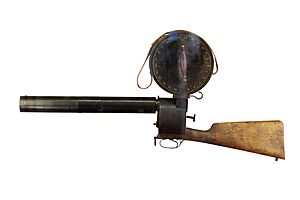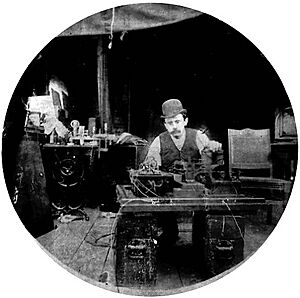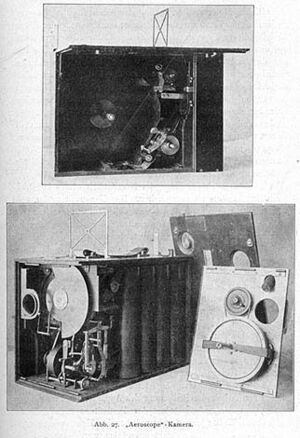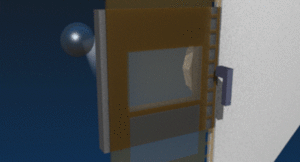Movie camera facts for kids
A movie camera is a special type of camera. It quickly takes many pictures, one after another. These pictures can be stored on film stock or a digital image sensor. When these pictures are played back fast enough, they create a moving image on a screen.
Think of it like a flipbook! A regular camera takes just one picture. But a movie camera captures a series of pictures, called frames. These frames are then shown using a movie projector or video projector. They are played at a certain speed, like 24 frames every second. Our eyes and brain then blend these separate pictures into one smooth, moving picture. This is how we see movies and videos!
Contents
The Story of Movie Cameras
The idea of capturing movement goes way back. In 1845, Francis Ronalds invented a camera. It slowly pulled a special paper past a lens. This allowed it to record changes over 12 or 24 hours. His cameras were used in science for over a century.
A big step forward was the chronophotographic gun. Étienne-Jules Marey, a French scientist, invented it in 1882. This gun could shoot 12 pictures every second! It was the first invention to capture moving images on a single plate.
Many inventors worked on movie cameras. In 1888, Louis Le Prince in England designed a camera. He used it to film short moving pictures on paper film. These included the Roundhay Garden Scene and Leeds Bridge.
Another important inventor was Eadweard Muybridge. In 1878, he set up 12 cameras. They took pictures of a horse running. Wires triggered the cameras as the horse passed. This showed how horses moved.
William Friese-Greene in Britain also experimented. In 1889, he patented a camera. It could take up to ten pictures per second. He even sent details of his invention to Thomas Edison in America.

William Kennedy Laurie Dickson worked for Edison. In 1891, he designed the Kinetograph camera. This camera used an electric motor. It could shoot film with special holes, called sprockets. These holes helped the film move smoothly. This was a key step for making movies.
The Lumière brothers, Auguste and Louis Lumière, also made a camera. Their chief mechanic, Charles Moisson, built it in 1894. They later used celluloid film. In 1894, Kazimierz Prószyński from Poland made a machine. It was both a projector and a camera. He called it the Pleograph.
Cameras for Everyone
By the mid-1890s, movie cameras were becoming real. Many companies started making them. These included famous names like Pathé and Bell & Howell.
The Aeroscope was a big invention. Polish inventor Kazimierz Prószyński built it around 1909. It was the first successful hand-held movie camera. The cameraman didn't need to turn a crank. This meant they could hold the camera with both hands. It was great for filming from airplanes or for military use.
The Bell & Howell Standard (1911-12) was the first all-metal movie camera. In 1923, Eastman Kodak introduced 16mm film. This film was cheaper than the larger 35mm film. Many camera makers then created models for amateur filmmakers. Even though 16mm was thought to be lower quality, cameras using it were made until the 2000s.
Digital Movie Cameras
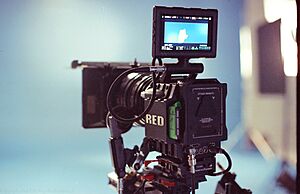
Today, most movie cameras are digital. They don't use film like old cameras. Instead, they use an electronic image sensor. The pictures are saved on hard drives or flash memory. Even digital SLR cameras (DSLRs) are used for some movies.
Since the 2010s, digital cameras have become the main type used in movies and TV. Some famous directors, like Martin Scorsese, still prefer film. They feel film captures more depth and emotion. He even started a group called The Film Foundation to help keep film alive.
How Movie Cameras Work
Movie cameras have many parts similar to a movie projector. They need to hold the film tightly and move it smoothly. The camera also has a special opening called an iris aperture on the lens. This controls how much light gets in.
The standard speed for movies with sound is 24 frames per second. Most movies use 35-millimeter wide film. But there are many other film formats. Different countries also use different video speeds and resolutions for TV.
Sound with Movies
One challenge in filmmaking is matching sound to the picture. Most movie cameras don't record sound inside. Instead, sound is recorded separately using special equipment. This is called "double-system recording."
Older news cameras sometimes recorded sound directly onto the film. This was either done optically (burning a sound wave onto the film) or magnetically (using a magnetic strip on the film).
Modern cameras often use "sync" motors. These motors make sure the film moves at a very precise speed. This helps keep the sound and picture perfectly in sync. They are also designed to be quiet. This way, the camera noise doesn't get into the sound recording.
To help match sound and picture, filmmakers use a clapper board. You've probably seen it! Someone claps it at the start of a scene. This sound and the image of the clapper closing give editors a clear point to match the audio and video. Digital cameras make this easier. They capture both video and audio at the same time.
Cameras for Home Movies
Before World War II, people could buy movie cameras for home use. These often used 9.5 mm or 16 mm film. After the war, home movie cameras became very popular. They were smaller, lighter, and more affordable.
In 1921, Emanuel Goldberg designed a small 35mm camera called the Kinamo. It was for amateurs and semi-professionals. Later, a spring motor was added. This allowed people to hold the camera and film easily.
Early home movie cameras often had simple lenses. Better ones might have three or four lenses on a spinning part. Many of these cameras used clockwork motors. A simple motor might run for 30 seconds. A better one could run for over a minute.
A common film for these cameras was Standard 8. This was a 16mm wide film. You would expose one half, then flip the film to expose the other half. After developing, the film was cut down the middle and joined. This gave you twice as much film!
In the 1960s, a new film format arrived: Super8. It came in a cassette, making it easy to load. Super8 cameras also used batteries. They could even record sound, though the quality wasn't always great. As costs dropped, these cameras became very popular.
Today, digital video cameras have mostly replaced these film cameras. And now, many people just use their smartphone cameras to record videos at home!
See also
- Animation camera
- Camcorder
- Camera stabilizer
- Digital movie camera
- Eyemo and Filmo
- History of cinema
- List of film formats
- Konvas
- Multiplane camera
- Debrie Parvo
- Prestwich Camera
- Professional video camera
- Video camera



